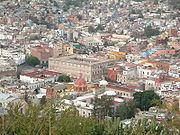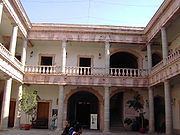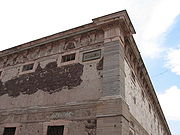
Alhóndiga de Granaditas
Encyclopedia


Guanajuato, Guanajuato
Guanajuato is a city and municipality in central Mexico and the capital of the state of the same name. It is located in a narrow valley, which makes the streets of the city narrow and winding. Most are alleys that cars cannot pass through, and some are long sets of stairs up the mountainsides....
, Mexico
Mexico
The United Mexican States , commonly known as Mexico , is a federal constitutional republic in North America. It is bordered on the north by the United States; on the south and west by the Pacific Ocean; on the southeast by Guatemala, Belize, and the Caribbean Sea; and on the east by the Gulf of...
. This historic building was created to replace an old granary near the city's river. Its construction lasted from 1798 to 1809, by orders of Juan Antonio de Riaño y Bárcena, a Spaniard who was the quartermaster
Quartermaster
Quartermaster refers to two different military occupations depending on if the assigned unit is land based or naval.In land armies, especially US units, it is a term referring to either an individual soldier or a unit who specializes in distributing supplies and provisions to troops. The senior...
of the city during the Viceroyalty of New Spain
New Spain
New Spain, formally called the Viceroyalty of New Spain , was a viceroyalty of the Spanish colonial empire, comprising primarily territories in what was known then as 'América Septentrional' or North America. Its capital was Mexico City, formerly Tenochtitlan, capital of the Aztec Empire...
. The building received World Heritage listing as part of the Historic Town of Guanajuato in 1988.
Architecture
The Alhóndiga measures 72 by 68 metres, with a height of 23 metres, and occupies an area of 4,828 square metres. It is constructed on the side of a hill and two of its sides are surrounded by elevations, a consequence of the odd geography in the city. There are no ornamental facets on the exterior, except for a few windows at the top of each storage room. It has cornices built in a DoricDoric order
The Doric order was one of the three orders or organizational systems of ancient Greek or classical architecture; the other two canonical orders were the Ionic and the Corinthian.-History:...
style, constructed with two types of regional stone—reddish and greenish. This gives it a curious appearance, resembling a stronghold or a castle, which it has come to be called by the people of Guanajuato. In the interior, there is a porch that leads to a spacious central patio. The porch contains Tuscan
Tuscany
Tuscany is a region in Italy. It has an area of about 23,000 square kilometres and a population of about 3.75 million inhabitants. The regional capital is Florence ....
columns and adornments. There are two staircases that lead to the upper floor. The Alhóndiga has only two access doors, a small one facing the east, adorned by two columns, and a large door of the same basic style, facing the north. The edifice was used for the buying and selling of wheat, corn, and other grains. Prior to the Mexican independence
Mexican War of Independence
The Mexican War of Independence was an armed conflict between the people of Mexico and the Spanish colonial authorities which started on 16 September 1810. The movement, which became known as the Mexican War of Independence, was led by Mexican-born Spaniards, Mestizos and Amerindians who sought...
from Spain
Spain
Spain , officially the Kingdom of Spain languages]] under the European Charter for Regional or Minority Languages. In each of these, Spain's official name is as follows:;;;;;;), is a country and member state of the European Union located in southwestern Europe on the Iberian Peninsula...
, it was used as a warehouse, military barracks, and prison. Currently it serves as a regional museum.
Mexican Independence


Miguel Hidalgo
Miguel Gregorio Antonio Ignacio Hidalgo y Costilla y Gallaga Mandarte Villaseñor , more commonly known as Miguel Hidalgo y Costilla or simply Miguel Hidalgo, was a Mexican priest and a leader of the Mexican War of Independence.In 1810 Hidalgo led a group of peasants in a revolt against the dominant...
's insurgent troops threatened to take over this city during the Mexican War of Independence
Mexican War of Independence
The Mexican War of Independence was an armed conflict between the people of Mexico and the Spanish colonial authorities which started on 16 September 1810. The movement, which became known as the Mexican War of Independence, was led by Mexican-born Spaniards, Mestizos and Amerindians who sought...
, Riaño secured himself in the Alhóndiga on 1810-09-28, along with many other Spaniards and some rich criollos. Riaño believed that the strength of the building and its positioning would make it easy to repel the insurgents' attacks. This belief held up at first, but soon the insurgents surrounded the building and began throwing rocks. Riaño died in this attack. The insurgents decided to burn down the eastern door to be able to enter and attack the civlians inside. The man chosen to perform this task was Juan José Martínez "El Pípila
El Pípila
El Pípila is the nickname of a local hero of the city of Guanajuato in Mexico. His real name was Juan José de los Reyes Martínez Amaro , son of Pedro Martínez and María Rufina Amaro. The name is also given to a monument built in his honor in the same city. Pípila is the Mexican Spanish word for a...
", an extraordinarily strong local miner. He tied a large flat stone to his back to protect himself from the bullet and rock storm expected once he entered. He poured petroleum on the door and lit it using a torch. When the door burnt down, the attackers stormed into the Alhóndiga, led by Martínez. Most of the people hiding in the building, most of them Spanish families from the outskirts of the city, were murdered, the building sacked. At the end of the day, hundreds of bodies were buried, and the whole city of Guanajuato pillaged. This event would encourage Hidalgo not to attack Mexico City, afraid his followers would repeat the massacres and looting of Guanajuato.
These first insurgents eventually fell. The four main participants—Miguel Hidalgo
Miguel Hidalgo
Miguel Gregorio Antonio Ignacio Hidalgo y Costilla y Gallaga Mandarte Villaseñor , more commonly known as Miguel Hidalgo y Costilla or simply Miguel Hidalgo, was a Mexican priest and a leader of the Mexican War of Independence.In 1810 Hidalgo led a group of peasants in a revolt against the dominant...
, Ignacio Allende
Ignacio Allende
Ignacio José de Allende y Unzaga , born Ignacio Allende y Unzaga, was a captain of the Spanish Army in Mexico who came to sympathize with the Mexican independence movement. He attended the secret meetings organized by Josefa Ortiz de Domínguez, where the possibility of an independent New Spain was...
, Juan Aldama
Juan Aldama
Juan Aldama was a Mexican revolutionary rebel soldier during the Mexican War of Independence in 1810. He was also the brother of Ignacio Aldama....
, and José Mariano Jiménez
José Mariano Jiménez
José Mariano Jiménez was a Mexican engineer and rebel officer active at the beginning of the Mexican War of Independence....
were beheaded. The four heads were hung from the corners of the Alhóndiga, to discourage other independence movements. The heads remained hanging for ten years, until Mexico achieved its independence. They were then taken to Mexico City
Mexico City
Mexico City is the Federal District , capital of Mexico and seat of the federal powers of the Mexican Union. It is a federal entity within Mexico which is not part of any one of the 31 Mexican states but belongs to the federation as a whole...
and put to rest under el Ángel de la Independencia
El Ángel
El Ángel de la Independencia , most commonly known by theshortened name El Ángel and officially known as Columna de la Independencia, is a victory column located on a roundabout over Paseo de la Reforma in downtown Mexico City.El Ángel was built to commemorate the centennial of the beginning of...
.
Public Venue
Attached to one side of the Alhóndiga is a large plaza with a set of wide steps that rise to meet the edge of the building. During the annual International Cervantino FestivalFestival Internacional Cervantino
The Festival Internacional Cervantino takes place each fall in the city of Guanajuato, located in central Mexico. This is a small colonial-era city with history of having a large cultural scene. The origins of the festival are from the mid 20th century, when short plays by Miguel de Cervantes...
, this space is converted into a large open air auditorium for live performances. The shows (often music and dance by groups of worldwide acclaim) are free to the general public, with reserved seats directly below the stage.

